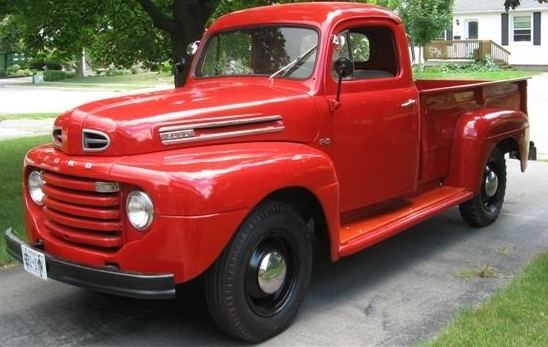Manufacturer Ford Production November 27, 1947–1952 | Also called Ford Bonus-Built Model years 1948–1952 | |
 | ||
Assembly Chester, Pennsylvania, USADearborn, Michigan, USAEdison, New Jersey, USALong Beach, California, USANorfolk , VirginiaSt. Paul, MinnesotaSt. Louis, Missouri, USAHapeville, Georgia, USAHighland Park, Michigan, USA | ||
The first-generation Ford F-Series is a series of pickup trucks and commercial vehicles produced by Ford. Introduced in 1947, the F-Series was the first post-war truck design from Ford. In a break from previous Ford trucks, the F-Series was no longer based upon its car chassis, but on a dedicated truck platform. This generation of the F-Series would remain in production until 1952. F-Series trucks were assembled at sixteen different Ford factories. Serial numbers indicate the truck model, engine, year, assembly plant, and unit number. The most common model was the F-1 with a 6 ½-foot bed followed by the F-2 and F-3 Express models with an 8-foot (2.4 m) bed.
Contents
Design
The first F-Series truck (known as the Ford Bonus-Built) was introduced in late 1947 (went on sale January 16, 1948) as a replacement for the previous car-based pickup line introduced in 1941. It had a flat, one-piece windshield and integrated headlamps. It had a wider cab. Options included the "See-Clear" windshield washer (operated by foot plunger), passenger-side windshield wiper & sun visor, and passenger-side taillight. The F-1 truck was also available with additional chrome trim and two horns as an option. All F-series were available with optional "Marmon-Herrington All Wheel Drive" until 1959.
Design of the F-Series truck changed tremendously from 1950 to 1954. From 1947 to 1950, the grill was a series of horizontal bars and the headlights were set into the fenders. For 1951 and 1952, the headlights were connected by a wide aerodynamic cross piece with three similarly aerodynamic supports. The rear window was wider in these later trucks and the dashboard was redesigned. This new cab was called the "Five-Star Cab".
Models
The F-Series was sold in four basic models. Along with the pickup truck (F-1 through F3), the F-Series was sold as a panel truck (based on the pickup), COE/cab-over engine chassis (F-5 and F-6, branded C-Series) and school bus chassis (F-5 and F-6, branded B-Series). Above the F-5, the F-Series was a medium-duty and heavy-duty conventional truck sharing the bodywork of the smaller F-Series.
The models are:
Variation by Year:
Transmissions
All are manual.
